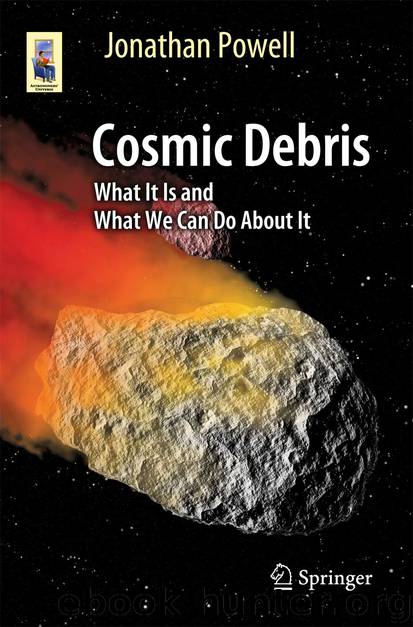Cosmic Debris by Jonathan Powell

Author:Jonathan Powell
Language: eng
Format: epub
Publisher: Springer International Publishing, Cham
Strikes on Other Worlds
Collisions between bodies in the Solar System continued long after its formation, with the peak of activity occurring during an interval called Late Heavy Bombardment (LHB) , around 4.1–3.8 billion years ago. The LHB period is thought to be the phase of evolution in the Solar System that was to eventually shape the terrestrial planets and moons. It could even be when life itself commenced, as planets gained atmospheres and other crucial elements that could well have established the premise for existence. The LHB period corresponds to the Neohadean and Eoarchean eras on Earth .
Our own Moon provides us with ‘living’ evidence of the continual bombardment of debris from space right up to the present day. It is believed that the Moon’s crust formed around 3900 million years ago in a division of the Moon’s evolution known as the pre-Nectarian period, with the next geological phase in lunar history, the Nectarian, in line with the LHB period. Pitted, cratered, and scarred, the Moon continues to be struck on a daily basis, but with its smaller mass it poses less of a target, and with no atmosphere to protect itself from even the smallest of objects that would readily burn up in our own atmosphere, it really is open season all year round for our lunar companion.
A lot of what has hit Earth has either fallen on wasteland or uninhabitable areas, or most likely in the sea, given the land-to-sea ratio. But there is one particular strike that continues to challenge the eye, the Barringer meteor crater in Arizona. The crater represents in plain view all that we associate with a direct hit: a substantial indentation on Earth , and testimony to what can and still could happen when all the other documented strikes on Earth are but confined to the textbooks, with no visible evidence. Here, some 50,000 years ago, relatively recent in Earth’s history, an iron meteorite plowed into the ground. The impact from this 30-m traveler caused a crater 1.2 km wide, leaving a permanent scar on the planet’s surface.
It is estimated that over 3000 meteorites measuring over 1 kg reach Earth every year with, to date, around 160 impact craters having been recognized, the Barringer crater being the biggest and most substantial. It is this crater that should serve as testimony to what such a relatively small body can inflict on Earth . As with the Tunguska event , the question of the level of destruction once again springs to mind, were the Barringer crater to be relocated into the middle of a city.
Because of the advancement in technology, we are being made acutely aware on a daily basis as to what bodies are out there, with regard to size, composition, and trajectories, even labeling them with names should their status and presence deserve such. For centuries these objects have been constant in Earth’s evolution , even today wandering silently through space as citizens on Earth go about their daily business. Does it do
Download
This site does not store any files on its server. We only index and link to content provided by other sites. Please contact the content providers to delete copyright contents if any and email us, we'll remove relevant links or contents immediately.
| Automotive | Engineering |
| Transportation |
Whiskies Galore by Ian Buxton(41532)
Introduction to Aircraft Design (Cambridge Aerospace Series) by John P. Fielding(32890)
Small Unmanned Fixed-wing Aircraft Design by Andrew J. Keane Andras Sobester James P. Scanlan & András Sóbester & James P. Scanlan(32574)
Craft Beer for the Homebrewer by Michael Agnew(17935)
Turbulence by E. J. Noyes(7702)
The Complete Stick Figure Physics Tutorials by Allen Sarah(7143)
Kaplan MCAT General Chemistry Review by Kaplan(6597)
The Thirst by Nesbo Jo(6439)
Bad Blood by John Carreyrou(6277)
Modelling of Convective Heat and Mass Transfer in Rotating Flows by Igor V. Shevchuk(6225)
Learning SQL by Alan Beaulieu(6037)
Weapons of Math Destruction by Cathy O'Neil(5832)
Man-made Catastrophes and Risk Information Concealment by Dmitry Chernov & Didier Sornette(5650)
Digital Minimalism by Cal Newport;(5392)
Life 3.0: Being Human in the Age of Artificial Intelligence by Tegmark Max(5188)
iGen by Jean M. Twenge(5163)
Secrets of Antigravity Propulsion: Tesla, UFOs, and Classified Aerospace Technology by Ph.D. Paul A. Laviolette(4994)
Design of Trajectory Optimization Approach for Space Maneuver Vehicle Skip Entry Problems by Runqi Chai & Al Savvaris & Antonios Tsourdos & Senchun Chai(4843)
Electronic Devices & Circuits by Jacob Millman & Christos C. Halkias(4749)
